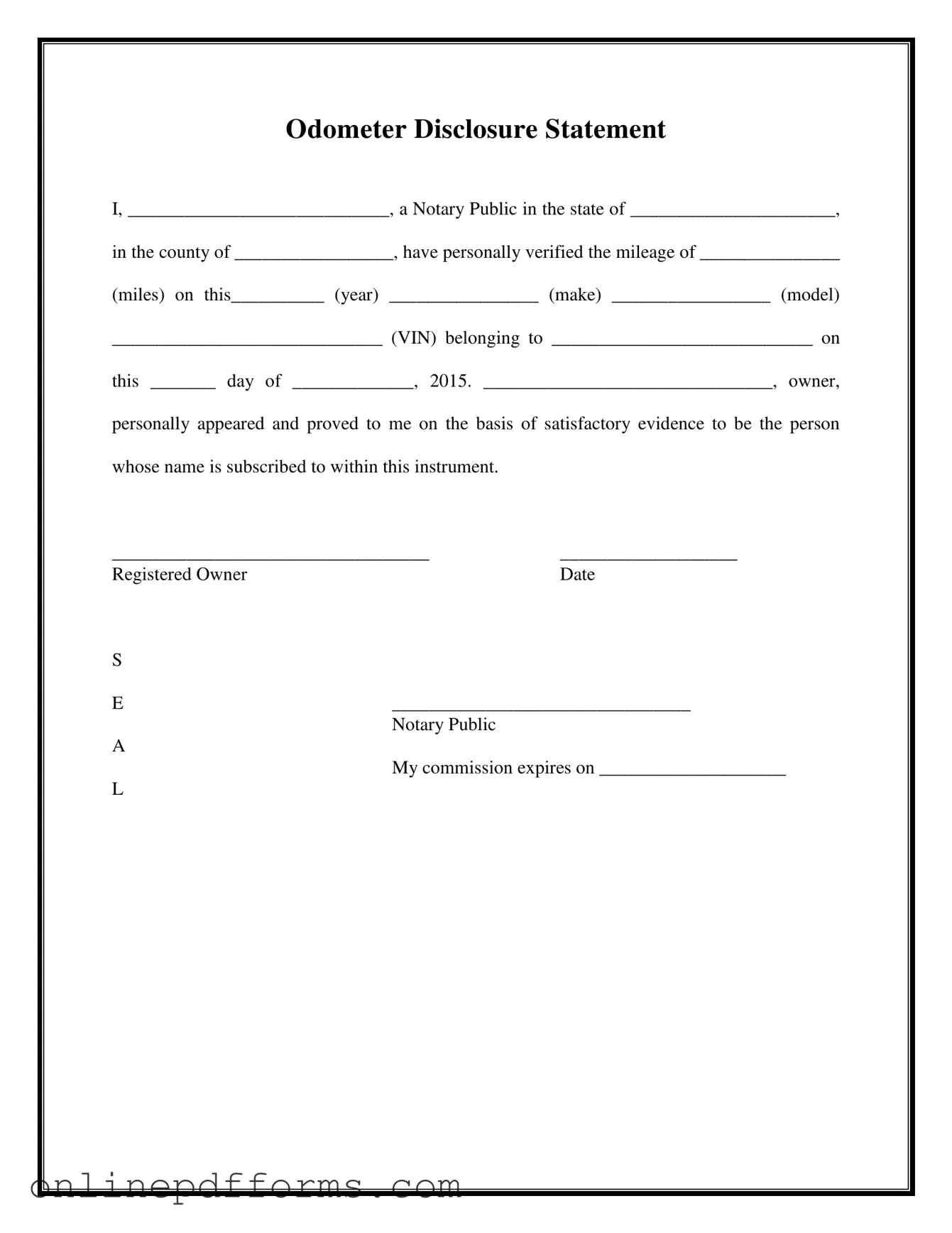The Notarized Odometer Statement is similar to a Vehicle Title. A vehicle title serves as the legal document that establishes ownership of a vehicle. It typically includes information such as the vehicle identification number (VIN), make, model, and the owner's name. Both documents are crucial in the transfer of ownership, as the title verifies the legal right to sell or transfer the vehicle, while the odometer statement confirms the mileage at the time of sale, protecting the buyer from potential fraud.
The Bill of Sale is a crucial document in vehicle transactions. Similar to the Notarized Odometer Statement, it serves as proof of transfer of ownership from the seller to the buyer. This essential form includes details like the vehicle identification number (VIN), make, model, and the sale price of the vehicle. Just like the odometer statement, it must be signed by both parties involved in the transaction to validate the document and provide protection against future disputes. The formal acknowledgement of both signatures ensures a clear understanding of the terms of sale and provides a record for both the buyer and seller. For more information on ownership transfer, you can refer to Auto Bill of Sale Forms.
Another document that resembles the Notarized Odometer Statement is the Bill of Sale. A Bill of Sale is a written agreement that documents the transfer of ownership of personal property, including vehicles. It includes details about the buyer, seller, and the item being sold. Like the odometer statement, the Bill of Sale often includes information about the vehicle's condition and mileage, serving as evidence of the transaction and providing a level of protection for both parties involved.
The Affidavit of Vehicle Ownership is also comparable to the Notarized Odometer Statement. This affidavit is a sworn statement that asserts the ownership of a vehicle, often used when a title is lost or unavailable. Similar to the odometer statement, it requires notarization to confirm the identity of the person claiming ownership. Both documents serve to establish legitimacy and protect against disputes regarding vehicle ownership.
A Vehicle Registration form shares similarities with the Notarized Odometer Statement as well. This document is issued by the state to register a vehicle, linking it to the owner. It contains vital information, including the VIN, make, model, and owner’s details. The odometer statement complements the registration by providing a verified mileage reading, ensuring that the information on the registration is accurate at the time of sale.
The Manufacturer's Certificate of Origin (MCO) is another document akin to the Notarized Odometer Statement. The MCO is issued by the manufacturer and serves as proof of ownership for a new vehicle before it is registered. It contains details such as the VIN, make, and model. Like the odometer statement, it is essential for establishing the vehicle's history and ensuring that the mileage is accurately represented during the initial sale.
The Vehicle History Report is also relevant in this context. This report provides a comprehensive history of a vehicle, including past ownership, accidents, and mileage records. While it does not require notarization, it serves a similar purpose by offering transparency regarding the vehicle's condition and history, much like the odometer statement aims to prevent odometer fraud during a sale.
Another similar document is the Power of Attorney for Vehicle Transactions. This document allows one person to act on behalf of another in the sale or transfer of a vehicle. It often includes details about the vehicle, including the VIN and mileage. Both the Power of Attorney and the Notarized Odometer Statement require notarization to confirm the identities of the individuals involved, ensuring that the transaction is legitimate.
Lastly, the DMV Release of Liability form is comparable to the Notarized Odometer Statement. This form notifies the Department of Motor Vehicles that the seller is no longer responsible for the vehicle after the sale. It includes details about the vehicle and the seller's information. Like the odometer statement, it serves to protect the seller from future liabilities associated with the vehicle, confirming that the sale has taken place and providing a record of the transaction.
